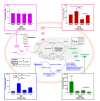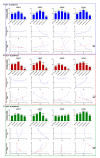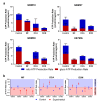Beyond the Warburg Effect: Oxidative and Glycolytic Phenotypes Coexist within the Metabolic Heterogeneity of Glioblastoma
- PMID: 33498369
- PMCID: PMC7922554
- DOI: 10.3390/cells10020202
Beyond the Warburg Effect: Oxidative and Glycolytic Phenotypes Coexist within the Metabolic Heterogeneity of Glioblastoma
Abstract
Glioblastoma (GBM) is the most aggressive primary brain tumor, with a median survival at diagnosis of 16-20 months. Metabolism represents a new attractive therapeutic target; however, due to high intratumoral heterogeneity, the application of metabolic drugs in GBM is challenging. We characterized the basal bioenergetic metabolism and antiproliferative potential of metformin (MF), dichloroacetate (DCA), sodium oxamate (SOD) and diazo-5-oxo-L-norleucine (DON) in three distinct glioma stem cells (GSCs) (GBM18, GBM27, GBM38), as well as U87MG. GBM27, a highly oxidative cell line, was the most resistant to all treatments, except DON. GBM18 and GBM38, Warburg-like GSCs, were sensitive to MF and DCA, respectively. Resistance to DON was not correlated with basal metabolic phenotypes. In combinatory experiments, radiomimetic bleomycin exhibited therapeutically relevant synergistic effects with MF, DCA and DON in GBM27 and DON in all other cell lines. MF and DCA shifted the metabolism of treated cells towards glycolysis or oxidation, respectively. DON consistently decreased total ATP production. Our study highlights the need for a better characterization of GBM from a metabolic perspective. Metabolic therapy should focus on both glycolytic and oxidative subpopulations of GSCs.
Keywords: energy metabolism; gene expression profiling; glioblastoma; glycolysis; oxidative phosphorylation; therapeutics.
Conflict of interest statement
The authors declare no conflict of interest.
Figures






Similar articles
-
Downregulated CLIP3 induces radioresistance by enhancing stemness and glycolytic flux in glioblastoma.J Exp Clin Cancer Res. 2021 Sep 6;40(1):282. doi: 10.1186/s13046-021-02077-4. J Exp Clin Cancer Res. 2021. PMID: 34488821 Free PMC article.
-
High expression of RFX4 is associated with tumor progression and poor prognosis in patients with glioblastoma.Int J Neurosci. 2021 Jan;131(1):7-14. doi: 10.1080/00207454.2020.1732969. Epub 2020 Mar 2. Int J Neurosci. 2021. PMID: 32075484
-
Metabolic heterogeneity and plasticity of glioma stem cells in a mouse glioblastoma model.Neuro Oncol. 2018 Feb 19;20(3):343-354. doi: 10.1093/neuonc/nox170. Neuro Oncol. 2018. PMID: 29016888 Free PMC article.
-
The Glioblastoma Microenvironment: Morphology, Metabolism, and Molecular Signature of Glial Dynamics to Discover Metabolic Rewiring Sequence.Int J Mol Sci. 2021 Mar 24;22(7):3301. doi: 10.3390/ijms22073301. Int J Mol Sci. 2021. PMID: 33804873 Free PMC article. Review.
-
Energy Metabolism in IDH1 Wild-Type and IDH1-Mutated Glioblastoma Stem Cells: A Novel Target for Therapy?Cells. 2021 Mar 22;10(3):705. doi: 10.3390/cells10030705. Cells. 2021. PMID: 33810170 Free PMC article. Review.
Cited by
-
Lactate-Loaded Nanoparticles Induce Glioma Cytotoxicity and Increase the Survival of Rats Bearing Malignant Glioma Brain Tumor.Pharmaceutics. 2022 Jan 29;14(2):327. doi: 10.3390/pharmaceutics14020327. Pharmaceutics. 2022. PMID: 35214059 Free PMC article.
-
Mitoepigenetics and gliomas: epigenetic alterations to mitochondrial DNA and nuclear DNA alter mtDNA expression and contribute to glioma pathogenicity.Front Neurol. 2023 May 30;14:1154753. doi: 10.3389/fneur.2023.1154753. eCollection 2023. Front Neurol. 2023. PMID: 37332990 Free PMC article. Review.
-
Drug-Induced Reorganisation of Lipid Metabolism Limits the Therapeutic Efficacy of Ponatinib in Glioma Stem Cells.Pharmaceutics. 2024 May 29;16(6):728. doi: 10.3390/pharmaceutics16060728. Pharmaceutics. 2024. PMID: 38931850 Free PMC article.
-
Roles of STAT3 in the pathogenesis and treatment of glioblastoma.Front Cell Dev Biol. 2023 Feb 27;11:1098482. doi: 10.3389/fcell.2023.1098482. eCollection 2023. Front Cell Dev Biol. 2023. PMID: 36923251 Free PMC article. Review.
-
Ceramide Composition in Exosomes for Characterization of Glioblastoma Stem-Like Cell Phenotypes.Front Oncol. 2022 Jan 21;11:788100. doi: 10.3389/fonc.2021.788100. eCollection 2021. Front Oncol. 2022. PMID: 35127492 Free PMC article.
References
-
- Ostrom Q.T., Gittleman H., Farah P., Ondracek A., Chen Y., Wolinsky Y., Stroup N.E., Kruchko C., Barnholtz-Sloan J.S. CBTRUS Statistical Report: Primary Brain and Central Nervous System Tumors Diagnosed in the United States in 2006–2010. Neuro-Oncology. 2013;15:ii1–ii56. doi: 10.1093/neuonc/not151. - DOI - PMC - PubMed
-
- Tamimi A.F., Juweid M. Glioblastoma [Internet] Codon Publications; Singapore: 2017. Epidemiology and Outcome of Glioblastoma. 201921345W. - PubMed
-
- Louis D.N., Perry A., Reifenberger G., Von Deimling A., Figarella-Branger D., Cavenee W.K., Ohgaki H., Wiestler O.D., Kleihues P., Ellison D.W. The 2016 World Health Organization Classification of Tumors of the Central Nervous System: A summary. Acta Neuropathol. 2016;131:803–820. doi: 10.1007/s00401-016-1545-1. - DOI - PubMed
-
- Verhaak R.G., Hoadley K.A., Purdom E., Wang V., Qi Y., Wilkerson M.D., Miller C.R., Ding L., Golub T., Mesirov J.P., et al. Integrated Genomic Analysis Identifies Clinically Relevant Subtypes of Glioblastoma Characterized by Abnormalities in PDGFRA, IDH1, EGFR, and NF1. Cancer Cell. 2010;17:98–110. doi: 10.1016/j.ccr.2009.12.020. - DOI - PMC - PubMed
Publication types
MeSH terms
Substances
Grants and funding
LinkOut - more resources
Full Text Sources
Other Literature Sources
Medical

